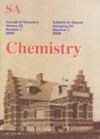作为一种低成本吸附剂定量吸收污染水体中多类农药残留的风叶花
IF 1
4区 化学
Q4 CHEMISTRY, MULTIDISCIPLINARY
South African Journal of Chemistry-Suid-Afrikaanse Tydskrif Vir Chemie
Pub Date : 2020-01-01
DOI:10.17159/0379-4350/2020/v73a4
引用次数: 7
摘要
研究了以风铃花为原料,定量去除污染水体中的莠去津、重嗪农、百菌清、灭螨灵、杀虫灵和灭螨灵的方法。用红外光谱分析了该吸附剂的表面化学性质,并用间歇吸附技术研究了其吸附效率。研究了pH(5 ~ 9)、吸附剂用量(0.1 ~ 0.5 g)、接触时间(100 ~ 140 min)、摇动速度(100 ~ 300 rpm)和初始农药浓度(3.15 ~ 100 μ L)为潜在的实验参数,并利用最佳条件下的浓度和接触时间对农药吸附平衡和动力学模型的影响。吸附平衡的结果更符合Langmuir等温线模型,而不是Freundlich吸附模型,表明单层均匀表面条件。另一方面,所有农药在吸附剂上的吸附动力学都用伪二阶模型很好地定义了。结果表明,利用该植物是一种有前途的、天然的、易获得的、低成本的高效、定量去除污染水中农药的吸附剂。本文章由计算机程序翻译,如有差异,请以英文原文为准。
Flower of Typha latifolia as a Low-cost Adsorbent for Quantitative Uptake of Multiclass Pesticide Residues from Contaminated Waters
The quantitative removal of atrazine, diazinon, chlorothalonil, ametryn, chlorpytrifos and dimethametryn from contaminated water was studied using flower of the Typha latifolia. The surface chemistry of this adsorbent was analyzed by FT-IR and the adsorption efficiency was studied using batch adsorption technique. The potential experimental parameters studied were pH (5–9), the dose of adsorbent (0.1–0.5 g), contact time (100–140 min), shaking speed (100–300 rpm) and initial pesticide concentration (3.15–100 μg L). The effects of concentration and contact time at the optimum conditions were used to study equilibrium and kinetic models for pesticide sorption. Results of the sorption equilibria were found to fit better to the Langmuir isotherm model than the Freundlich adsorption model indicating monolayer homogeneous surface conditions. On the other hand, kinetics of all pesticides sorption on the adsorbent was well defined by the pseudo-second-order model. The results obtained showed that the use of this plant be considered as one of the promising, natural, easily accessible and low-cost adsorbent for efficient and quantitative removal of pesticides from contaminated water.
求助全文
通过发布文献求助,成功后即可免费获取论文全文。
去求助
来源期刊
CiteScore
3.10
自引率
0.00%
发文量
6
审稿时长
>12 weeks
期刊介绍:
Original work in all branches of chemistry is published in the South African Journal of Chemistry. Contributions in English may take the form of papers, short communications, or critical reviews.

 求助内容:
求助内容: 应助结果提醒方式:
应助结果提醒方式:


